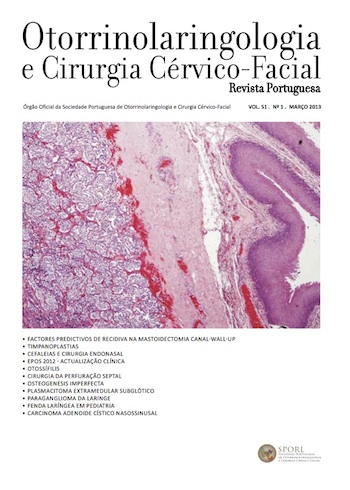Pediatric voice disorders at Hospital Dona Estefânica: Casuistic before and after distal chip videolaryngoscopy
DOI:
https://doi.org/10.34631/sporl.1054Keywords:
Dysphonia, Voice Disorders, Laryngoscopes, Stroboscopy, PediatricsAbstract
Objective: To describe the casuistic of the Voice Unit at Hospital Dona Estefânia and compare the diagnoses obtained with flexible fiberoptic videolaryngoscopy and distal chip flexible videolaryngoscopy.
Study design: Retrospective observational study.
Material and Methods: Review of clinical records from patients first evaluated from September 2018 to December 2021.
Results: Videolaryngoscopy was obtained in 78.1% of the 73 studied children. The following diagnoses were made: vocal fold nodules (42.5%),laryngopharyngeal reflux (12.3%), muscle tension dysphonia (9.6%), corditis (2.7%), vocal fold cyst (2.7%) and vocal fold polyp (1.4%). There was nostatistically significant difference in the diagnoses made using distal chip videolaryngoscopy, but we noticed a decrease in the proportion of vocal fold nodules and normal laryngoscopies and an increase in the proportion of laryngopharyngeal reflux (p = 0.479).
Conclusion: Distal chip videolaryngoscopy did not change the diagnoses made in children with chronic dysphonia.
Downloads
References
Ramos PH, Álvarez ML, León NI, Badía PI, Napolitano CA. Voice disorders in children: experience in the voice unit at Universidad Católica Clinical Hospital. J Voice. 2022 Mar;36(2):293.e1-293.e5. doi: 10.1016/j.jvoice.2020.04.035.
Possamai V, Hartley B. Voice disorders in children. Pediatr Clin North Am. 2013 Aug;60(4):879-92. doi: 10.1016/j.pcl.2013.04.012.
Landa M, Palicio I, Álvarez L, Martínez Z. Revisión de nuestra experiencia en fonocirugía infantil. Acta Otorrinolaringol Esp. 2017 Sep-Oct;68(5):269-273. doi: 10.1016/j.otorri.2016.11.008.
Mortensen M, Schaberg M, Peak W. Diagnostic contributions of videolaryngostroboscopy in the pediatric population. Arch Otolaryngol Head Neck Surg. 2010 Jan;136(1):75-9. doi: 10.1001/archoto.2009.209.
Martins RH, Hidalgo Ribeiro CB, Fernandes de Mello BM, Branco A, Tavares EL. Dysphonia in children. J Voice. 2012 Sep;26(5):674.e17-20. doi: 10.1016/j.jvoice.2012.03.004.
Merati AL, Keppel K, Braun NM, Blumin JH, Kerschner JE. Pediatric voice-related quality of life: findings in healthy children and in common laryngeal disorders. Ann Otol Rhinol Laryngol. 2008 Apr;117(4):259-62. doi: 10.1177/000348940811700404.
Scholman C, Westra JM, Zwakenberg MA, Dikkers FG, Halmos GB, Wedman J, Wachters JE, F. A. M. van der Laan BFAM, Plaat BEC. High‑defnition videolaryngoscopy is superior to fberoptic laryngoscopy: a 111 multi‑observer study. Eur Arch Otorhinolaryngol. 2021 Jun;278(6):1927-32. doi: 10.1007/s00405-021-06673-0.
Scholman C, Westra JM, Zwakenberg MA, Dikkers FG, Halmos GB, Wedman J, Wachters JE, F. A. M. van der Laan BFAM, Plaat BEC. Differences in the diagnostic value between fiberoptic and high definition laryngoscopy for the characterisation of pharyngeal and laryngeal lesions: A multi-observer paired analysis of videos. Clin Otolaryngol. 2020 Jan;45(1):119-25. doi: 10.1111/coa.13476.
Block BB, Brodsky L. Hoarseness in children: the role of laryngopharyngeal reflux. Int J Pediatr Otorhinolaryngol. 2007 Sep;71(9):1361-9. doi: 10.1016/j.ijporl.2006.10.029
Saniasiaya J, Kulasegarah J. Dysphonia and reflux in children: A systematic review. Int J Pediatr Otorhinolaryngol. 2020 Dec;139:110473. doi: 10.1016/j.ijporl.2020.110473.
Dohar JE, Shaffer AD, White KE. Pediatric dysphonia: It's not about the nodules. Int J Pediatr Otorhinolaryngol. 2019 Oct;125:147-152. doi: 10.1016/j.ijporl.2019.06.031.
Hron TA, Kavanagh KR, Murray N. Diagnosis and treatment of benign pediatric lesions. Otolaryngol Clin North Am. 2019 Aug;52(4):657-668. doi: 10.1016/j.otc.2019.03.010.
Mansour J, Amir O, Sagiv D, Alon EE, Wolf M, Primov-Fever A. The Accuracy of preoperative rigid stroboscopy in the evaluation of voice disorders in children. J Voice. 2017 Jul;31(4):516.e1-516.e4. doi: 10.1016/j.jvoice.2016.12.013.
Ongkasuwan J, Devore D, Hollas S, Yan J. Transoral rigid 70-degree laryngoscopy in a pediatric voice clinic. Laryngoscope. 2019 Jul;129(7):1657-1659. doi: 10.1002/lary.27706.
Akif Kiliç M, Okur E, Yildirim I, Güzelsoy S. The prevalence of vocal fold nodules in school age children. Int J Pediatr Otorhinolaryngol. 2004 Apr;68(4):409-12. doi: 10.1016/j.ijporl.2003.11.005.
Centeno D, Maximiliano P. Characterization of patients with dysphonia evaluated in the pediatric voice unit of the Dr. Luis Calvo Mackenna Hospital. Rev. Otorrinolaringol. Cir. Cabeza Cuello. [Internet] 2019; 79:18-24. Available from: https://www.scielo.cl/pdf/orl/v79n1/0718-4816-orl-79-01-0018.pdf
Downloads
Published
How to Cite
Issue
Section
License
Copyright (c) 2023 The authors retain copyright of this article.

This work is licensed under a Creative Commons Attribution-ShareAlike 4.0 International License.






